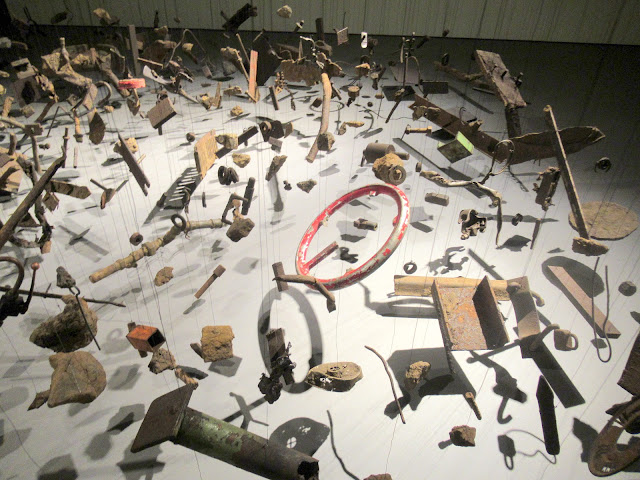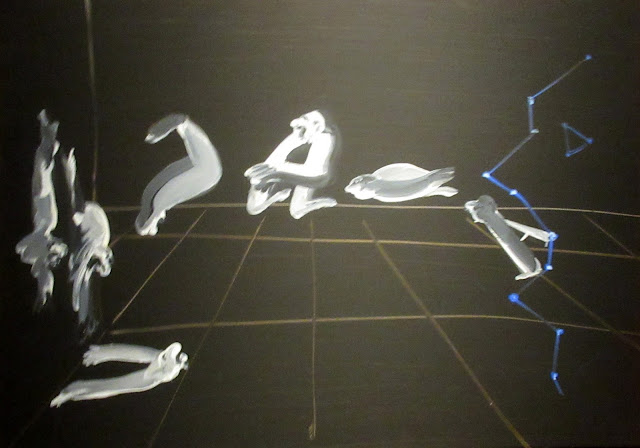The exhibition Women Together, is the first rehang of the museum's collection in its permanent home, (the former FIX brewery), since the initial presentation in 2019. (You can find out more about the building itself and its history here )
The exhibition is an attempt to address a major issue confronting all museums today: the under-representation of women and the urgency regarding gender equality.
There are a total of 49 works by different artists, ten of which are Greek.
Cornelia Parker,
Dress, Shot by Pearl Necklace, 1995,
Suit, Shot by Small Change, 1995
The two works are the literal representation of the titles they bear. Using the pearls of a necklace and coins as bullets, the artist shot a woman's velvet dress and a man's suit. The 'corpses' of these destroyed garments serve as the spectral presences of the protagonists in a fictional narrative, partially alluding to the ironic and subsersive use of gender stereotypes.
looking closer
looking closer
An installation of an assembly of objects collected by the artist from the subsoil of Dusseldorf using a metal detector. Through this gesture, Parker symbolically 'rummaged' through her past, the trauma of WWII, and particularly the silence engulfed around it on the part of her German mother. Among the remnants of an archaeological excavation and the waste of the urban environment, the objects on display are suspended from the floor at a height equal to the depth from which they were extracted.
'My work is constantly unstable... hovering, or so fragile it might collapse. Perhaps that's what I feel, about my own relationship to the world. It is a universal condition, that of vulnerability. We don't have solid, fixed lives; we're consistently dealing with what life throws us'.
looking closer
Paky Vlassopoulou, A Day After a Day, After a Day, After a Day, 2023, (porcelain)
Despina Meimaroglou, A Pack of Lies, 1997, (C-print on aluminium)
A Pack of Lies consists of a series of photographic prints that depict three variations on the face of an aged Barbie doll, as well as its full-body portrayal bearing signs of physical abuse. For these works, Meimaroglou used early image processing applications to combine aspects of the toy doll with photographs of mature women in a gesture that epitomises the non-realistic standards of beauty and their relation with direct or latent physical violence.
Christina Dimitriadis, Berlin/Studio, 1995, (C-print)
Christina Dimitriadis, Thessaloniki/Livingroom II, 1995, (C-print)
Thessaloniki/Living Room II and Berlin/Studio are part of the Private Spaces series with which Dimitriadis engaged in the mid-1990s and delved into what she calls 'living environments'. These entail a series of directed self-portraits of her in intimate, private interior spaces, such as her parents' home or her apartment in Germany. The artist is blurrily portrayed due to the prolonged exposure time, as a result of which she appears to dissolve into the surrounding space. Through these works, she explored family relationships in an autobiographical manner, posing questions about how we 'exist' inside our private spaces.
Sixteen round canvasses depicting olive trees. Their number corresponds to the number of supercentenarian olive trees in the village of Bchaaleh in South Lebanon, which, according to the local tradition, have existed since Noah's Biblical Deluge.
Hera Buyuktasciyan, Nothing Further Beyond, 2021, (industrial carpet, metal and wood)
This installation traces the layers of history beneath an architectural ruin in Istanbul, the Triumphal Arch of Emperor Theodosius I, which was erected in 395 AD and today is situated in Beyazit Square. The teardrop-like motifs that adorn the monument's columns symbolise the club of Hercules, the weapon he used to accomplish his twelve labours. Theodosius ordered that the arch be installed in such a way that it would point towards the Pillars of Hercules, which, according to legend, were placed by Hercules himself at the far end of the West side to signify the end of the known world and protect it from sea monsters. With the Latin phrase 'Non plus ultra' (nothing further beyond) inscribed upon them, as the legend goes, the Pillars delineate the borders of western civilisation, designating anything beyond them as 'other'. For her sculptural installation, Buyuktasciyan uses carpets that resemble geological strata in order to mimic the multiple narratives that exist among the ruins and remain latent within each layer.
Annette Messager, Soeux Sous Fillet, 1997, (black and white photos, net)
Maria Tsagkari, I Couldn't Bear Living Without You, 2017, (natural human hair, wooden poles, acrylic paint)
This installation is inspired by the ritual offerings left beside altars in Roman Catholic churches, often in gratitude for answered prayers. Evoking these so-called ex-votos, dozens of small photographs of body parts are hung from an array of black cords and veiled by a black net. Messager conceives of a female, intimate unviverse that alludes to the paradoxical and fragmentary nature of identity.
To see more of Messager's work go here
The work was realised in 2000, 26 years after the Turkish invasion of Cyprus. The pile of dolls made out of clothes and fabric scraps from people close to the artist, signifies a pile from the conqueror's loot and plunder: it serves as a means to remember the traumatic past and opens up possibilities of recognition, healing and eventually, redemption.






























No comments:
Post a Comment